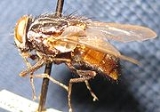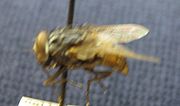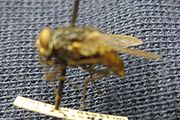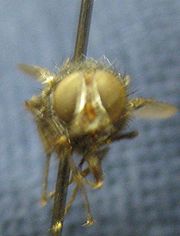
Synthesiomyia nudiseta
Encyclopedia
Synthesiomyia nudiseta is one of the largest flies
in the family Muscidae
. The fly has a pair of forewings; the paired hind wings have been reduced to halteres
that help with stability and movement during flight. Key characteristics of this species include plumose (that is, "feathery") segmented aristae
, well-developed calypters, and sternopleural bristles. Synthesiomyia nudiseta is a forensically important species because it is necrophilous
and can therefore help determine the time of colonization for the post mortem interval
with its known life cycle.
Synthesiomyia nudiseta is essentially a kind of necrophagous fly. Larva
e of S. nudiseta were found in a cadaver in Costa Rica
, and the larvae have also been shown to be important on decomposition of carcasses in Malaysia. S. nudiseta are said to be useful in the recognition of the range of post-death, and of importance to forensic entomology. In Brazil
, S. nudiseta is very common in Rio de Janeiro, where it is highly synanthropic
.
 The Synthesiomyia nudiseta fly is one of the largest muscid
The Synthesiomyia nudiseta fly is one of the largest muscid
s, roughly 7 to 10 mm in length. As an adult fly, its abdomen is gray with a pattern resembling a checkerboard, similar to the type found on flesh flies. This species can be misidentified as a small sarcophagid; however, it can be easily separated from sarcophagids because the thorax
consists of four longitudinal stripes and the terminal segment of the abdomen is yellow instead of red. The antennae and palpi also are orange or yellow in color. In more detail, the posterior spiracles on the adult fly have s- shaped slits, which allow for air to enter the insect’s trachea
. It also contains a highly chitin
ized and complete peritreme.
More significant characteristics of S. nudiseta are its large and predacious larvae which can easily consume C. rufiffacies. Spiracular buttons are present in the premature third instar
. The anterior spiracles contain five to seven papillae each. The puparia are enclosed in a silky white substance for protection.
It is also closely related to Muscina differing primarily in the precise details of larval and adult morphology and in its location. Furthermore, some significant identifying characteristics for the adult flies in the family musicdae include a pair of antennae, three segmented plumose aristae
, a frontal suture, well developed calypters, hypo pleura without bristles, and more than one sternopleural bristles. The distinct parastomal sclerite in the second instar larva can be known as its most unusual identifying characteristic.
 Larvae prefer carrion
Larvae prefer carrion
as their primary source of food but have been found in feces, rotting vegetable materials, and garbage. These larvae only feed on the surface of their food instead of burrowing in like other larvae in the same order. It has also been found that the larvae of S. nudiseta are very large and predacious. They are known to devour the larvae of Chrysomya Rufifacies
, commonly known as the hairy maggot blow fly
.
 The life cycle of S. nudiseta from egg to adult lasts anywhere between 22–30 days and includes 3 instars. The species survives best in room temperature and warm environments, the optimal range for survival is anywhere from 25-31 degrees Celsius. S. nudiseta can introduce from four to nine generations per year. The higher the temperature is the larger the generation number will be.
The life cycle of S. nudiseta from egg to adult lasts anywhere between 22–30 days and includes 3 instars. The species survives best in room temperature and warm environments, the optimal range for survival is anywhere from 25-31 degrees Celsius. S. nudiseta can introduce from four to nine generations per year. The higher the temperature is the larger the generation number will be.
The entire larval stage for S. nudiseta lasts for approximately 13–15 days. Through research and experimentation, it has been found that the developmental period for the first instar
is about 24 hours, the period is greater for the second instar, approximately 48 hours and the third instar has the longest developmental period at 230 hours.
The first instar of the larval stage is between 1.5–3 mm long. These larvae have been found to have a very high mortality rate when compared to other larvae at this stage of development. There is only approximately a 65% survival rate after this instar. At the second instar, the larvae are 3–7 mm long and have a very high level of viability. During the third instar level, the larvae are 7-19.5 mm. This level is broken down into two stages. The first stage is when the larvae continue to feed and collect nutrients needed during pupation. The second stage of development is when the third instar larvae begin the search for a suitable place to pupate where it can begin the pre-pupal stage.
During the pre-pupal stage, the larvae begin to excrete a silk-like white liquid from their salivary glands which solidifies into a sort of scleritized protective film from which the puparium will form. The puparium is 7–8 mm in length and a brown-red color. The puparium is covered by a dirty white cocoon.
Pupation occurs relatively close to the food source of the S. nudiseta larvae because they tend to not typically migrate very far. S. nudiseta larvae are one of the few species that can successfully pupate in a confined location. Besides the encasing cocoon, the outside environment is also helpful to the protection of this puparium since dust and soil particles have been found coating the outside surface.

and Malta
.
. Like other Muscidae
species, it prefers to surround itself in a wide range from garbage to human and animal remains. S. nudiseta will pupate slowly and in a restricted environment, and prefer not to migrate far away from the resource. Therefore, in stages of decomposition
of forensic importance it is essential to verify all areas in close proximity to the corpse. Pupa
have typically been found in victims’ clothing in places such as the elastic waistbands of pants, the inner surfaces of the victim’s clothing, and even in the space in between the body and the ground. In the life cycle during stages of decomposition, S. nudiseta will be inclined to pupate with other species of flies when they arrive later in different waves. Depending on where S. nudiseta happens to be located geographically can affect how delayed the fly will take to pupate. For instance, in Hawaii, S. nudiseta is apt to feed on carrion as a food source and pupation invades similar to the flesh fly genus Sarcophaga
, which is the second general decomposition wave.
Diptera
Diptera , or true flies, is the order of insects possessing only a single pair of wings on the mesothorax; the metathorax bears a pair of drumstick like structures called the halteres, the remnants of the hind wings. It is a large order, containing an estimated 240,000 species, although under half...
in the family Muscidae
Muscidae
Muscidae are a family of flies found in the superfamily Muscoidea. The apical segment of the antennae of Muscidae are plumose, and the basal portion is smooth....
. The fly has a pair of forewings; the paired hind wings have been reduced to halteres
Halteres
Halteres are small knobbed structures modified from the hind wings in some two-winged insects. They are flapped rapidly and function as gyroscopes, informing the insect about rotation of the body during flight....
that help with stability and movement during flight. Key characteristics of this species include plumose (that is, "feathery") segmented aristae
Arista (biology)
In insect anatomy the arista is a simple or variously modified apical or subapical bristle, arising from the third antennal segment. It is the evolutionary remains of antennal segments, and may sometimes show signs of segmentation...
, well-developed calypters, and sternopleural bristles. Synthesiomyia nudiseta is a forensically important species because it is necrophilous
Scavenger
Scavenging is both a carnivorous and herbivorous feeding behavior in which individual scavengers search out dead animal and dead plant biomass on which to feed. The eating of carrion from the same species is referred to as cannibalism. Scavengers play an important role in the ecosystem by...
and can therefore help determine the time of colonization for the post mortem interval
Post mortem interval
Post-mortem interval is the time that has elapsed since a person has died. If the time in question is not known, a number of medical/scientific techniques are used to determine it. This also can refer to the stage of decompostion the person is in....
with its known life cycle.
Classification
The species Synthesiomyia nudiseta, was named by Van der Wulp in 1883; and S. nudiseta is the only known species under the genus Synthesiomyia.Synthesiomyia nudiseta is essentially a kind of necrophagous fly. Larva
Larva
A larva is a distinct juvenile form many animals undergo before metamorphosis into adults. Animals with indirect development such as insects, amphibians, or cnidarians typically have a larval phase of their life cycle...
e of S. nudiseta were found in a cadaver in Costa Rica
Costa Rica
Costa Rica , officially the Republic of Costa Rica is a multilingual, multiethnic and multicultural country in Central America, bordered by Nicaragua to the north, Panama to the southeast, the Pacific Ocean to the west and the Caribbean Sea to the east....
, and the larvae have also been shown to be important on decomposition of carcasses in Malaysia. S. nudiseta are said to be useful in the recognition of the range of post-death, and of importance to forensic entomology. In Brazil
Brazil
Brazil , officially the Federative Republic of Brazil , is the largest country in South America. It is the world's fifth largest country, both by geographical area and by population with over 192 million people...
, S. nudiseta is very common in Rio de Janeiro, where it is highly synanthropic
Synanthrope
Synanthropes is a term applied to species of wild animals and plants of various kinds that live near, and benefit from, an association with humans and the somewhat artificial habitats that humans create around them . Those habitats include houses, gardens, farms, roadsides, garbage dumps, and so on...
.
Anatomy and defining characteristics

Muscidae
Muscidae are a family of flies found in the superfamily Muscoidea. The apical segment of the antennae of Muscidae are plumose, and the basal portion is smooth....
s, roughly 7 to 10 mm in length. As an adult fly, its abdomen is gray with a pattern resembling a checkerboard, similar to the type found on flesh flies. This species can be misidentified as a small sarcophagid; however, it can be easily separated from sarcophagids because the thorax
Thorax
The thorax is a division of an animal's body that lies between the head and the abdomen.-In tetrapods:...
consists of four longitudinal stripes and the terminal segment of the abdomen is yellow instead of red. The antennae and palpi also are orange or yellow in color. In more detail, the posterior spiracles on the adult fly have s- shaped slits, which allow for air to enter the insect’s trachea
Invertebrate trachea
The invertebrate trachea refers to the open respiratory system composed of spiracles, tracheae, and tracheoles that terrestrial arthropods have to transport metabolic gases to and from tissues....
. It also contains a highly chitin
Chitin
Chitin n is a long-chain polymer of a N-acetylglucosamine, a derivative of glucose, and is found in many places throughout the natural world...
ized and complete peritreme.
More significant characteristics of S. nudiseta are its large and predacious larvae which can easily consume C. rufiffacies. Spiracular buttons are present in the premature third instar
Instar
An instar is a developmental stage of arthropods, such as insects, between each molt , until sexual maturity is reached. Arthropods must shed the exoskeleton in order to grow or assume a new form. Differences between instars can often be seen in altered body proportions, colors, patterns, or...
. The anterior spiracles contain five to seven papillae each. The puparia are enclosed in a silky white substance for protection.
It is also closely related to Muscina differing primarily in the precise details of larval and adult morphology and in its location. Furthermore, some significant identifying characteristics for the adult flies in the family musicdae include a pair of antennae, three segmented plumose aristae
Arista (biology)
In insect anatomy the arista is a simple or variously modified apical or subapical bristle, arising from the third antennal segment. It is the evolutionary remains of antennal segments, and may sometimes show signs of segmentation...
, a frontal suture, well developed calypters, hypo pleura without bristles, and more than one sternopleural bristles. The distinct parastomal sclerite in the second instar larva can be known as its most unusual identifying characteristic.
Diet

Carrion
Carrion refers to the carcass of a dead animal. Carrion is an important food source for large carnivores and omnivores in most ecosystems. Examples of carrion-eaters include vultures, hawks, eagles, hyenas, Virginia Opossum, Tasmanian Devils, coyotes, Komodo dragons, and burying beetles...
as their primary source of food but have been found in feces, rotting vegetable materials, and garbage. These larvae only feed on the surface of their food instead of burrowing in like other larvae in the same order. It has also been found that the larvae of S. nudiseta are very large and predacious. They are known to devour the larvae of Chrysomya Rufifacies
Chrysomya rufifacies
Chrysomya rufifacies is a species belonging to the blow fly family, Calliphoridae, and is most significant in the field of forensic entomology due to its use in establishing or altering postmortem intervals. The common name for the species is the hairy maggot blow fly, and it belongs to the genus...
, commonly known as the hairy maggot blow fly
Chrysomya rufifacies
Chrysomya rufifacies is a species belonging to the blow fly family, Calliphoridae, and is most significant in the field of forensic entomology due to its use in establishing or altering postmortem intervals. The common name for the species is the hairy maggot blow fly, and it belongs to the genus...
.
Life cycle
The S. nudiseta flies are one of the first to arrive on the source of their food and lay their eggs, which are about 1.3 mm long. The larvae however, develop more slowly when compared to the larvae of the flies that arrive with S. nudiseta. Pupatation occurs even later with the larvae of the later arriving fly species.
The entire larval stage for S. nudiseta lasts for approximately 13–15 days. Through research and experimentation, it has been found that the developmental period for the first instar
Instar
An instar is a developmental stage of arthropods, such as insects, between each molt , until sexual maturity is reached. Arthropods must shed the exoskeleton in order to grow or assume a new form. Differences between instars can often be seen in altered body proportions, colors, patterns, or...
is about 24 hours, the period is greater for the second instar, approximately 48 hours and the third instar has the longest developmental period at 230 hours.
The first instar of the larval stage is between 1.5–3 mm long. These larvae have been found to have a very high mortality rate when compared to other larvae at this stage of development. There is only approximately a 65% survival rate after this instar. At the second instar, the larvae are 3–7 mm long and have a very high level of viability. During the third instar level, the larvae are 7-19.5 mm. This level is broken down into two stages. The first stage is when the larvae continue to feed and collect nutrients needed during pupation. The second stage of development is when the third instar larvae begin the search for a suitable place to pupate where it can begin the pre-pupal stage.
During the pre-pupal stage, the larvae begin to excrete a silk-like white liquid from their salivary glands which solidifies into a sort of scleritized protective film from which the puparium will form. The puparium is 7–8 mm in length and a brown-red color. The puparium is covered by a dirty white cocoon.
Pupation occurs relatively close to the food source of the S. nudiseta larvae because they tend to not typically migrate very far. S. nudiseta larvae are one of the few species that can successfully pupate in a confined location. Besides the encasing cocoon, the outside environment is also helpful to the protection of this puparium since dust and soil particles have been found coating the outside surface.

Distribution
Synthesiomyia nudiseta is found in tropical and subtropical regions. In the United States it is mainly collected from California to Texas and from North Carolina to Florida. Adult flies prefer direct sunlight and can usually be found outdoors. In Europe it is an introduced species and has only been recorded in SpainSpain
Spain , officially the Kingdom of Spain languages]] under the European Charter for Regional or Minority Languages. In each of these, Spain's official name is as follows:;;;;;;), is a country and member state of the European Union located in southwestern Europe on the Iberian Peninsula...
and Malta
Malta
Malta , officially known as the Republic of Malta , is a Southern European country consisting of an archipelago situated in the centre of the Mediterranean, south of Sicily, east of Tunisia and north of Libya, with Gibraltar to the west and Alexandria to the east.Malta covers just over in...
.
Forensic importance
Synthesiomyia nudiseta is a species that is found to be quite necrophilousScavenger
Scavenging is both a carnivorous and herbivorous feeding behavior in which individual scavengers search out dead animal and dead plant biomass on which to feed. The eating of carrion from the same species is referred to as cannibalism. Scavengers play an important role in the ecosystem by...
. Like other Muscidae
Muscidae
Muscidae are a family of flies found in the superfamily Muscoidea. The apical segment of the antennae of Muscidae are plumose, and the basal portion is smooth....
species, it prefers to surround itself in a wide range from garbage to human and animal remains. S. nudiseta will pupate slowly and in a restricted environment, and prefer not to migrate far away from the resource. Therefore, in stages of decomposition
Decomposition
Decomposition is the process by which organic material is broken down into simpler forms of matter. The process is essential for recycling the finite matter that occupies physical space in the biome. Bodies of living organisms begin to decompose shortly after death...
of forensic importance it is essential to verify all areas in close proximity to the corpse. Pupa
Pupa
A pupa is the life stage of some insects undergoing transformation. The pupal stage is found only in holometabolous insects, those that undergo a complete metamorphosis, going through four life stages; embryo, larva, pupa and imago...
have typically been found in victims’ clothing in places such as the elastic waistbands of pants, the inner surfaces of the victim’s clothing, and even in the space in between the body and the ground. In the life cycle during stages of decomposition, S. nudiseta will be inclined to pupate with other species of flies when they arrive later in different waves. Depending on where S. nudiseta happens to be located geographically can affect how delayed the fly will take to pupate. For instance, in Hawaii, S. nudiseta is apt to feed on carrion as a food source and pupation invades similar to the flesh fly genus Sarcophaga
Sarcophaga
Sarcophaga is a genus of true flies, the type of the flesh-fly family .This genus occurs essentially worldwide. These flies are generally well-sized and of a greyish color; like many of their relatives, the typical patterns are lengthwise darker stripes on the thorax and dark and light square dots...
, which is the second general decomposition wave.

